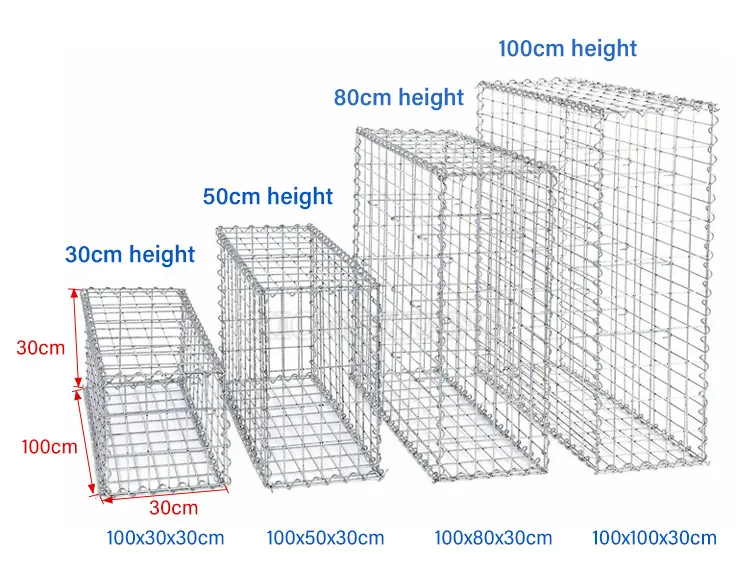
- Afrikaans
- Albanian
- Arabic
- Armenian
- Azerbaijani
- Basque
- Belarusian
- Bengali
- Bosnian
- Bulgarian
- Croatian
- Czech
- Danish
- Dutch
- English
- Esperanto
- Estonian
- Finnish
- French
- Galician
- Georgian
- German
- Greek
- hawaiian
- Hindi
- Hungarian
- Indonesian
- irish
- Italian
- Lao
- Latvian
- Lithuanian
- Luxembourgish
- Macedonian
- Maltese
- Myanmar
- Norwegian
- Polish
- Portuguese
- Romanian
- Russian
- Serbian
- Slovak
- Somali
- Spanish
- Swedish
- Thai
- Turkish
- Turkmen
- Vietnamese
Dic . 07, 2024 08:08 Back to list
gabion basket fill material
Gabion Basket Fill Material Understanding Its Importance and Applications
Gabion baskets, traditionally used in civil engineering and landscaping, are wire mesh containers filled with various materials. These structures have become increasingly popular for erosion control, retaining walls, and decorative landscaping due to their durability and aesthetic flexibility. However, the choice of fill material is crucial for the effectiveness and functionality of gabion baskets. In this article, we will explore the various types of fill materials, their benefits, and their applications.
Types of Fill Materials
1. Natural Stone Natural stone is one of the most common fill materials for gabion baskets. It is not only readily available but also offers excellent durability and stability. The use of rocks such as granite, limestone, and basalt ensures that the gabions withstand environmental pressures such as water flow and erosion. Additionally, natural stone blends seamlessly into the landscape, making it an aesthetically pleasing option.
2. Recycled Concrete As sustainability practices gain traction, recycled concrete has emerged as a popular fill material. It is an eco-friendly alternative that reduces landfill waste while providing structural integrity. This material can effectively absorb impact and minimize erosion, making it suitable for use in high-traffic areas and along waterways.
3. Gravel Gravel is another viable fill material, often chosen for its drainage capabilities. When using gabion baskets for applications like retaining walls or flood control, gravel allows water to pass through easily, reducing hydrostatic pressure. Moreover, the varied sizes of gravel allow for flexibility in usage, enhancing the functionality of the gabions.
4. Soil and Vegetation In landscaping applications, using soil combined with vegetation as fill material can promote ecological integration. This method is particularly effective in creating living walls, which not only serve structural purposes but also provide habitat for wildlife. The plants rooted in the soil help to stabilize the structure further while enhancing its visual appeal.
5. Other Materials Depending on the project requirements, other fill materials such as sand, recycled plastic, or even rubber can be used. Each of these materials offers distinct advantages and can be selected based on specific engineering or aesthetic needs.
Benefits of Using Gabion Baskets with Various Fill Materials
The selection of fill material in gabion baskets should be aligned with the intended purpose of the structure. Here are a few benefits of using gabion baskets filled with appropriate materials
gabion basket fill material

1. Erosion Control When placed along riverbanks or slopes, gabion baskets filled with natural stone or gravel help reduce the impact of water flow, preventing soil erosion. This makes them an invaluable tool in civil engineering and environmental conservation efforts.
2. Cost-Effectiveness Gabion baskets are relatively easy to install, and using locally sourced fill materials can significantly reduce project costs. Moreover, their longevity means that maintenance expenses are minimal over time.
3. Aesthetic Versatility With various fill options, gabion baskets can cater to different visual preferences. Whether you desire the rugged look of natural stone or a more uniform appearance with recycled concrete, gabion baskets can be tailored to suit any landscape design.
4. Environmentally Friendly Using recycled materials as fill for gabion baskets contributes to sustainability efforts. By repurposing materials that would otherwise contribute to landfill waste, the construction industry can move towards more sustainable building practices.
Applications of Gabion Baskets
Gabion baskets are extensively used in various applications, including
- Erosion control in waterway management. - Retaining walls for landscaping or structural support. - Noise barriers in urban environments. - Flood control structures to protect vulnerable areas. - Decorative features such as garden walls or planters.
Conclusion
The choice of fill material in gabion baskets plays a pivotal role in their performance, utility, and visual appeal. By understanding the benefits of different materials, engineers, landscapers, and architects can make informed decisions that enhance the functionality and aesthetic value of their projects. As the demand for sustainable and effective construction solutions grows, gabion baskets and their fill materials will undoubtedly remain a key player in modern engineering and landscape design.
-
Versatile Sheep and Livestock Hurdles for Sale
NewsApr.14,2025
-
The Rise of BRC Fencing
NewsApr.14,2025
-
High-Quality Cattle and Horse Panels for Sale
NewsApr.14,2025
-
Durable Cattle Fencing Solutions
NewsApr.14,2025
-
Double Wire Fencing Solutions
NewsApr.14,2025
-
360 Degree Protection with 358 Anti-Climb Fences
NewsApr.14,2025









